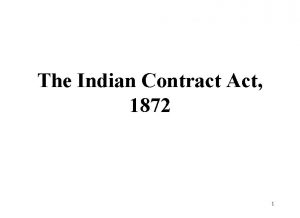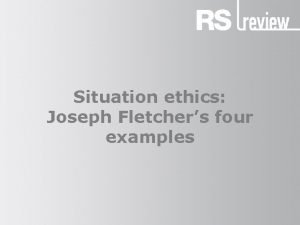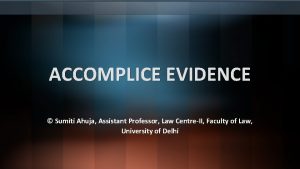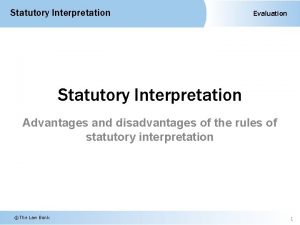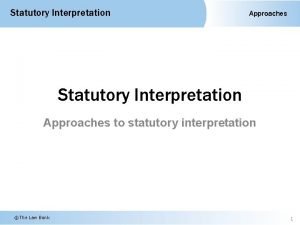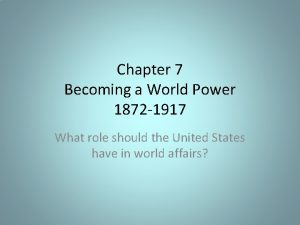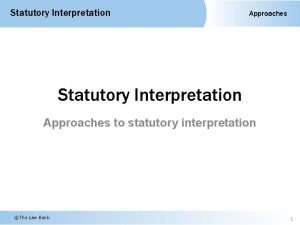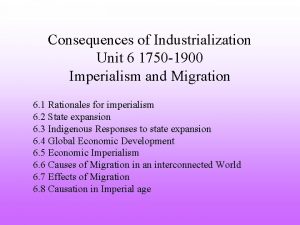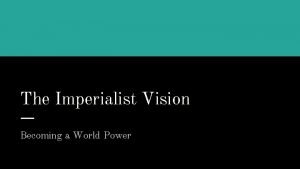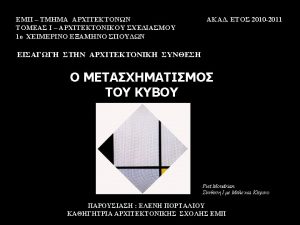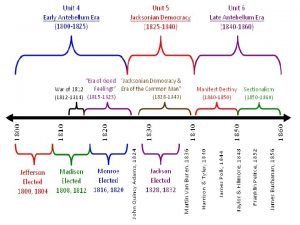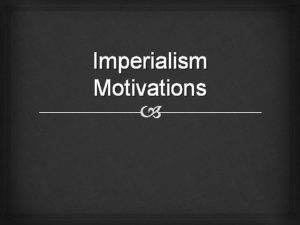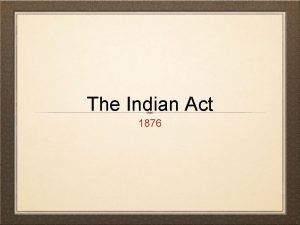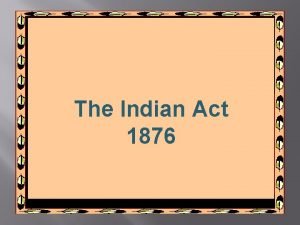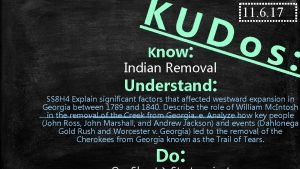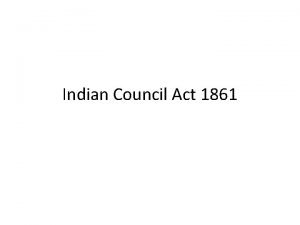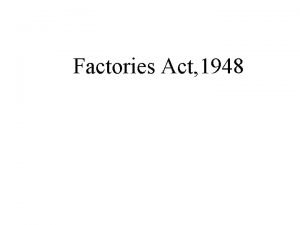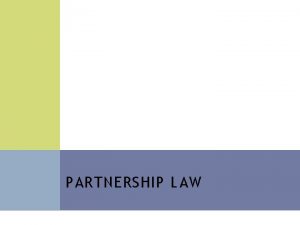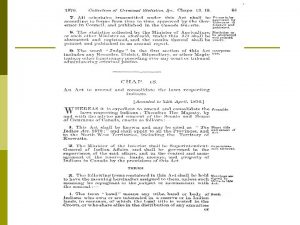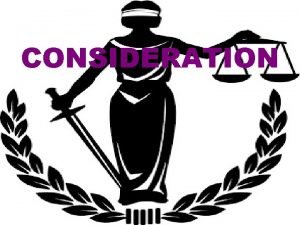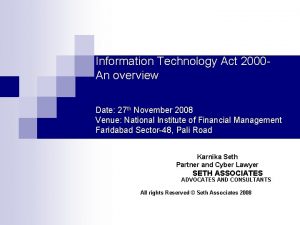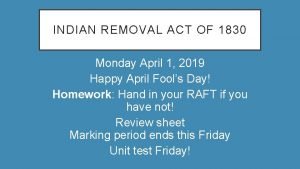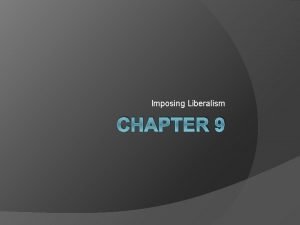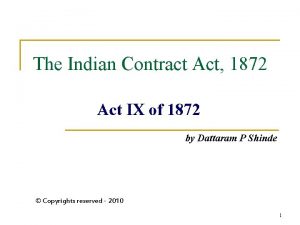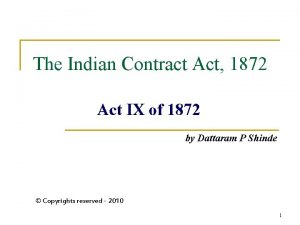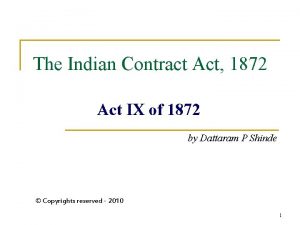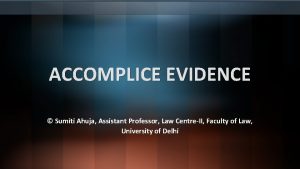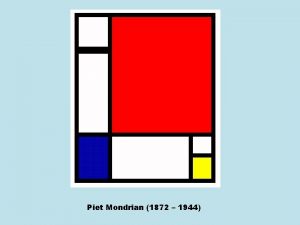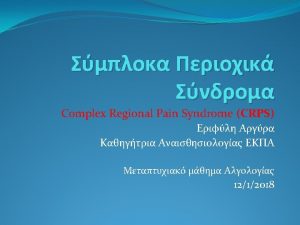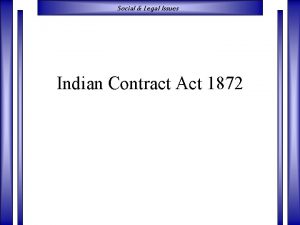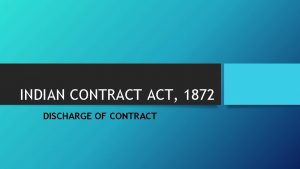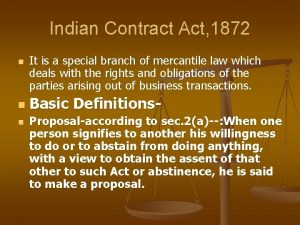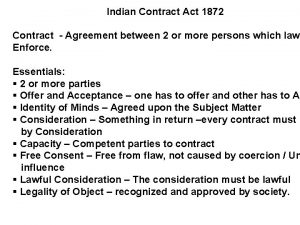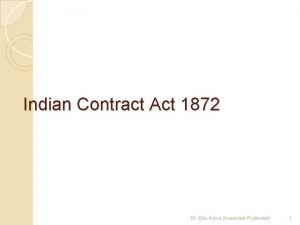PRESUMPTIONS UNDER THE INDIAN EVIDENCE ACT 1872 Sumiti













































- Slides: 45

PRESUMPTIONS UNDER THE INDIAN EVIDENCE ACT, 1872 © Sumiti Ahuja, Assistant Professor, Law Centre-II, University of

CONTENTS • Sections 4, 41, 105, 111 -A, 112, 113 -A, 113 -B, 114 and 114 -A of the Indian Evidence Act, 1872 (IEA). • Goutam Kundu v. State of West Bengal, AIR 1993 SC 2295 • Dipanwita Roy v Ronobroto Roy. AIR 2015 SC 418

DEFINITION OF PRESUMPTION • Cambridge Dictionary defines it as “the fact of believing that something is true without having any proof”. • Merriam Webster Dictionary defines it as “a legal inference as to the existence or truth of a fact not certainly known that is drawn from the known or proved existence of some other fact”. • Presumption is a “legal inference that must be made in light of certain facts. Most presumptions are rebuttable, meaning that they are rejected if proven to be false or at least thrown into sufficient doubt by the evidence. Other presumptions are conclusive, meaning that they must be accepted to be true without any opportunity for rebuttal”. [Source: LII, Cornell Law School]. • Black’s Law Dictionary (6 th edn. ) defines it as “a rule of law, statutory or judicial, by which finding of a basic fact gives rise to existence of presumed fact, until presumption is rebutted. ”

Presumptions are of 2 types: Presumptions of Fact and Presumptions of Law. Presumptions of Fact are always permissive, rebuttable and do not constitute a branch of jurisprudence. They are indicated in the IEA by the expression ‘may presume’ (refer sections 86 -88, 90 and 114). Presumptions of Law are always obligatory, may be rebuttable or irrebuttable, and constitute a branch of jurisprudence. Rebuttable Presumptions of Law are indicated in the IEA by the expression ‘shall presume’ (refer sections 79 -85, 89 and 105). Irrebuttable Presumptions of Law are indicated in the IEA by the expression ‘conclusive proof’ (refer sections 41, 112 and 113). PRESUMPTIONS Presumptions of Fact or, Natural Presumptions of Law or, Artificial Presumptions Rebuttable Presumptions of Law Irrebuttable Presumptions of Law

SECTION 4 OF THE INDIAN EVIDENCE ACT, 1872 Section 4, IEA, defines may presume, shall presume and conclusive proof as: “May presume”. –– Whenever it is provided by this Act that the Court may presume a fact, it may either regard such fact as proved, unless and until it is disproved, or may call for proof of it. “Shall presume”. –– Whenever it is directed by this Act that the Court shall presume a fact, it shall regard such fact as proved, unless and until it is disproved. “Conclusive proof”. –– When one fact is declared by this Act to be conclusive proof of another, the Court shall, on proof of the one fact, regard the other as proved, and shall not allow evidence to be given for the purpose of disproving it.

• May Presume: Leaves it to the discretion of the court to make presumption according to circumstances of case. • Example: The court may presume that an accomplice is unworthy of credit, unless he is corroborated in material particulars [Section 114(b)] • Shall Presume: Leaves no discretion or option with the court not to make presumption. Court is bound to take the fact as proved until evidence is given to disprove it. • Example: The court shall presume the genuineness of every government publication. [Section 84] • Conclusive Proof: Irrebuttable presumption; the court has no discretion at all and cannot call upon a party to prove that fact. • Example: The fact that any person was born during the continuance of a valid marriage between his mother and any man, or within two hundred and eighty days after its dissolution, the mother remaining unmarried, shall be conclusive proof that he is the legitimate son of that man, unless it can be shown that the parties to the marriage had no access to each other at any time when he could have been begotten. [Section 112]

MAY PRESUME Explained: Sections 113 -A and 114, IEA

SECTION 113 -A OF THE INDIAN EVIDENCE ACT, 1872 Section 113 A deals with Presumption as to abetment of suicide by a married woman. Read as: “When the question is whether the commission of suicide by a woman had been abetted by her husband or any relative of her husband it is shown that she had committed suicide within a period of seven years from the date of her marriage and that her husband or such relative of her husband had subjected her to cruelty, the court may presume, having regard to all the other circumstances of the case, that such suicide had been abetted by her husband or by such relative of her husband. Explanation. –– For the purposes of this section, “cruelty” shall have the same meaning as in section 498 A of the Indian Penal Code (45 of 1860). ”

• Section 113 -A, Evidence Act mandates that when a woman commits suicide within seven years of her marriage and it is shown that her husband or any relative of her husband had subjected her to cruelty as per the terms defined in Section 498 -A IPC, the court may presume that such suicide has been abetted by the husband or the relative, Pinakin Mahipatray Rawal v. State of Gujarat (2013) 10 SCC 48. • Essentials of this section are: o That the woman had committed suicide within the period of seven years after date of her marriage; o That her husband or such relative of her husband had subjected her to cruelty; o That the case of such suicide had been abetted by her husband or such relative of he husband.

• Presumption under this section is rebuttable and is totally based on facts. • Presumption of abetment of suicide can be drawn only by the prosecution has discharged the initial onus of proving cruelty. In such type of cases the court may call upon the prosecution to adduce sufficient evidence and to prove that it was a case of suicide abated by the husband or his relation. • The legal presumption provided under this provision clearly includes the past inference of cruelty spread over a period of seven years from the date of the marriage of the victim. • Where the deceased in her dying declaration stated that she poured kerosene on herself and lighted a match stick on account of ill- treatment and beating by her husband the court can draw a presumption under section 113 A of the Act. This kind of presumption is totally in the discretion of the court (i. e. , discretion of the court to make presumption according to circumstances of case).

• The Supreme Court, in Heera Lal v. State of Rajasthan (2017), has held that in a case of suicide of wife, acquittal of the relatives or husband under Section 498 A IPC (that happens when prosecution fail to prove instance of cruelty) will bar prosecution to use presumption available under Section 113 A of the Evidence Act to prove abetment to suicide under Section 306, IPC. A bench comprising Justice RF Nariman and Justice Mohan M Shantanagoudar also held that harassment is something of a lesser degree than cruelty, and the mere fact that there is a finding of harassment would not lead to the conclusion that there is “abetment of suicide”.

SECTION 114 OF THE INDIAN EVIDENCE ACT, 1872 Section 114 deals with Presumption by court about existence of certain facts. Read as: “The Court may presume the existence of any fact which it thinks likely to have happened, regard being had to the common course of natural events, human conduct and public and private business, in their relation to the facts of the particular case. ”

• Under section 114 of the Evidence Act the court has unfettered discretion to presume a fact, as proved until it is disproved, or ignore such a presumption and call for a proof of it. • This section authorizes the court to make certain presumptions of facts. They are all presumptions which may naturally arise, but the section, by the use of the word ‘may’ instead of ‘shall’, both in body of the section, and in the illustrations, shows that the court is not compelled to raise them, but is to consider whether, in the circumstances of the case, they should be raised (discretion).

• In Imran Khan v. State of Maharashtra, 2019 SCC On. Line Bom 46, dated 14 -01 -2019, Bombay High Court referred to Section 114 of the Evidence Act which provides that the court may presume the existence of certain facts. Illustration (a) of this section states that “a man who is in possession of stolen goods soon after theft is either the thief or has received the goods knowing them to be stolen, unless he can account for his possession. ” In this case, the petitioner was not able to rebut the presumption under Section 114 as he failed to account for the articles found in his possession immediately after theft. Conviction was upheld. • Brief Facts and Procedural History: The petitioner was chargesheeted for committing theft of gold ornaments and cash at night. As per the prosecution, after lodging of complaint in the matter, the petitioner was immediately arrested and was found in possession of gold ornaments and cash of Rs 2500 complained to be stolen. The matter went to trial and the petitioner was convicted under sections 380 and 457, IPC.

SHALL PRESUME Explained: Sections 105, 111 -A, 113 -B and 114 A IEA

SECTION 105 OF THE INDIAN EVIDENCE ACT, 1872 Section 105 deals with Burden of proving that case of accused comes within exceptions. Read as: “When a person is accused of any offence, the burden of proving the existence of circumstances bringing the case within any of the General Exceptions in the Indian Penal Code (45 of 1860) or within any special exception or proviso contained in any other part of the same Code, or in any law defining the offence, is upon him, and the Court shall presume the absence of such circumstances. ”

• In criminal trial (section only applicable to criminal cases), the Court shall presume the absence of circumstances which may bring the case of the accused within any of the general exceptions in the Indian Penal Code or within any special exception or provision contained in any part of the said Code or in law defining the offence. • Illustration: “A, accused of murder, alleges that, by reason of unsoundness of mind, he did not know the nature of the act. The burden of proof is on A” (illustration a of section 105, IEA). • The general principles relating to burden of proof are: (i) the accused is always presumed to be innocent, and (ii) it is upon prosecution to prove the guilt of the accused. It is only after the prosecution has discharged its initial traditional burden establishing the complicity of the accused, that burden to claim benefit of exception comes on accused.

• An accused is not required to adduce leading evidence to prove his case beyond reasonable doubt. The IEA “does not contemplate that the accused should prove his case with the same strictness and vigour as the prosecution is required to prove in a criminal charge. It is sufficient if he is able to prove his case by the standard of preponderance of probabilities envisaged by Section 105 of the Evidence Act. ” • Where an accused person in his statement under section 313, Cr. PC raised the defense of unsoundness of mind but the circumstances indicated that he acted under grave and sudden provocation. It has been held that the accused could not be denied the benefit of the defense of Exception 1 to Section 300 of IPC.

• In Elavarasan v. State Rep. by Inspector of Police (SC judgment dtd. July 05, 2011), it was held that, “in all the crimes in which the intention was an essential element, the accused could escape from the punishment if he was able to prove insanity either from the evidence of the prosecution or defence witnesses” However, in this case conviction of accused was made Section 304(2), IPC. Appellant had raised the defence of insanity and contended that his availability in the place of occurrence after the occurrence and earlier treatment for mental illness proved the defence which was resisted by the State. • Court held that: mere absence of fleeing from the scene of occurrence would not be a decisive factor to prove the insanity of the appellant. Medical treatment for mental illness would not be a defence unless such illness prevented the accused from deciding right or wrong. The conduct of the appellant showed that he was though not having an intention to murder his daughter but had knowledge of the consequences of his act.

SECTION 111 -A OF THE INDIAN EVIDENCE ACT, 1872 Section 111 -A deals with Presumption as to certain offences. Read as: “(1) Where a person is accused of having committed any offence specified in subsection (2), in – (a) any area declared to be a disturbed area under any enactment, for the time being in force, making provision for the suppression of disorder and restoration and maintenance of public order; or (b) any area in which there has been, over a period of more then one month, extensive disturbance of the public peace, and it is shown that such person had been at a place in such area at a time when fire-arms or explosives were used at or from that place to attack or resist the members of any armed forces or the forces charged with the maintenance of public order acting in the discharge of their duties, it shall be presumed, unless the contrary is shown, that such person had committed such offence. (2) The offences referred to in sub-section (1) are the following, namely : - (a) an offence under Section 121 -A, Section 122 or Section 123 of the Indian Penal Code (45 of 1860); (b) criminal conspiracy or attempt to commit, or abetment of, an offence under Section 122 or Section 123 of the Indian Penal Code.

• The Government amended the IEA to put the onus for proof of innocence on the accused person in casing involving terrorist activities. • This section was inserted by the Terrorist Affected Areas (Special Courts) Act, 1984 which came into force on 14. 7. 1984. In the chapter on procedure and powers of special courts in the Act, it has been provided that special court may take cognizance of any scheduled offence, without accused being committed to it for trial, upon receiving a complaint of facts which constitute such offence or upon a police report of such facts.

SECTION 113 -B OF THE INDIAN EVIDENCE ACT, 1872 • Section 113 -B of the IEA deals with Presumption as to dowry death. • Read as: “When the question is whether a person has committed the dowry death of a woman and it is shown that soon before her death such woman had been subjected by such person to cruelty or harassment for, or in connection with, any demand for dowry, the Court shall presume that such person had caused the dowry death. Explanation. - For the purpose of this section, "dowry death" shall have the same meaning as in Section 304 -B of Indian Penal Code (45 of 1860)]. ”

Essential condition s: That the presumption can be raised only if the accused is being tried for the offence under section 304 B, IPC. That the woman was subjected to cruelty or harassment by her husband or his relatives. That such cruelty or harassment was for or in connection with any demand for dowry. That such cruelty or harassment was soon before her death.

• The presumption of dowry death arises only in cases when the prosecution proves that before death the victim was subjected to cruelty or maltreatment or harassment for dowry demand. Hence, under this section when prosecution proves the case, it shall be presumed by the court that the death is a dowry death. • The Apex Court has observed that “there must be existence of a proximate and live-link between the effect of cruelty based on dowry demand the concerned death. ” • “A comparative study of Sections 11 З-А and 113 -В highlights that under Section 113 -A the court “may presume” having regard to all the other circumstances of the case, an abetment of suicide as visualized by Section 306, IPC, but Section 113 -B which is relatable to Section 304 -B, IPC the word “may” has been substituted by “shall’’ and there is no reference to the circumstances of the case. ”

• In Baijnath And Ors. v. State of M. P. (SC decision dtd. Nov. 18, 2016), it was held that: “The presumption (under section 113 B of the Evidence Act) as to dowry death thus would get activated only upon the proof of the fact that the deceased lady had been subjected to cruelty or harassment for or in connection with any demand for dowry by the accused and that too in the reasonable contiguity of death, ” the bench of Hon’ble Justices Dipak Misra and Amitava Roy said. • “Such a proof is thus the legislatively mandated prerequisite to invoke the otherwise statutorily ordained presumption of commission of the offence of dowry death by the person charged therewith. ”

SECTION 114 -A OF THE INDIAN EVIDENCE ACT, 1872 • Section 114 -A of the IEA, deals with Presumption as to absence of consent in certain prosecution for rape. • Read as: ‘In a prosecution for rape under clauses (a-n) of sub-section (2) of section 376 of the Indian Penal Code, where sexual intercourse by the accused is proved and the question is whether it was without the consent of the woman alleged to have been raped and such woman states in her evidence before the court that she did not consent, the court shall presume that she did not consent. Explanation. - In this section, “sexual intercourse” shall mean any of the acts mentioned in clauses (a) to (d) of section 375 of the Indian Penal Code. ]’

Essentials conditions : It should be proved that there was sexual intercourse. The question before the court should be whether such intercourse was with or without the consent of the woman. The woman must have stated, in her evidence before the court that she had not consented to the intercourse.

• If the mentioned conditions are satisfied the Court shall presume the absence of consent and the burden of proving consent will be on the accused. If he cannot prove consent he cannot be acquitted. The presumption under this Section is presumption of Law.

CONCLUSIVE PROOF Explained: Sections 41, 112 and 113 IEA

SECTION 41 OF THE INDIAN EVIDENCE ACT, 1872 • Section 41, IEA deals with Relevancy of certain judgments in exercise of probate, matrimonial, admiralty or insolvency jurisdiction. • Read as (Part-I): “A final judgment, order or decree of a competent Court, in the exercise of probate, matrimonial, admiralty or insolvency jurisdiction, which confers upon or takes away from any person any legal character, or which declares any person to be entitled to any such character, or to be entitled to any specific thing, not as against any specified person but absolutely, is relevant when the existence of any such legal character, or the title of any such person to any such thing, is relevant. ”

SECTION 41 OF THE INDIAN EVIDENCE ACT, 1872 (Contd. ) • Read as (Part-II): “Such judgment, order or decree is conclusive proof – • that any legal character which it confers accrued at the time when such judgment, order or decree came into operation; • that any legal character, to which it declares any such person to be entitled, accrued to that person at the time when such judgment, order or decree declares it to have accrued to that person; • that any legal character which it takes away from any such person ceased at the time from which such judgment, order or decree declared that it had ceased or should cease; and • that anything to which it declares any person to be so entitled was the property of that person at the time from which such judgment, order or decree declares that it had been or should be his property. ”

• Section 41, IEA, consists of two parts. The first part makes certain judgments relevant. The second part makes the judgments conclusive evidence of certain matters. • The conditions necessary for making a judgment relevant may be considered under two heads: those having reference to the contents of judgment, and those to the nature of the proceeding in which judgment is sought to be relied upon. • This section deals with judgments in rem, i. e. , judgments which are conclusive not only against the parties to them, but against the whole world.

Important definitions for Section 41, IEA PROBATE JURISDICTION • Jurisdiction of a court under the Indian Succession Act, 1925 in respect of testamentary and intestate matters. Judgment by a probate is a judgment-in-rem by which legal character of a person is granted. MATRIMONIAL JURISDICTION • By virtue of this jurisdiction the court can decide the legal status of a person whether one is married or widow or divorcee.

Important definitions for Section 41, IEA (Contd. ) ADMIRALTY JURISDICTION • The admiralty court decides cases arising out of war claims. It is exercised by the High Court under the Letters Patent. INSOLVENCY JURISDICTION • By exercising insolvency jurisdiction the court can determine legal status of a person whether he is insolvent or he is discharged from insolvency or annulment of his insolvency. The judgment of the court is judgment-in-rem and binding on all.

SECTION 112 OF THE INDIAN EVIDENCE ACT, 1872 Section 112, IEA, deals with Birth during marriage, conclusive proof of legitimacy.

SECTION 112 OF THE INDIAN EVIDENCE ACT, 1872 • Read as: “The fact that any person was born during the continuance of a valid marriage between his mother and any man, or within two hundred and eighty days after its dissolution, the mother remaining unmarried, shall be conclusive proof that he is the legitimate son of that man, unless it can be shown that the parties to the marriage had no access to each other at any time when he could have been begotten. ”

• The section is based on maxim pater rest quern nuptioe (he is the father whom the marriage indicates). • The sprit behind Section 112 is that once valid marriage is proved there is strong presumption about the legitimacy of children born during wedlock. • Section 112 is based on presumption of public morality and public policy. “It is a presumption founded upon public policy which requires that every child born during wedlock shall be deemed to be legitimate unless the contrary is proved. ” The effect of this section is that a child born as the result of sexual intercourse between husband wife is conclusively presumed to be their child. this presumption cannot be discarded by the mere chances of probabilities or any circumstance creating doubt.

• Section 112 has no application where maternity is in dispute and not paternity. • Proof of non-access at time when child could have been begotten is only outlet to escape vigour of conclusive presumption. “Non-access” refers to the non-existence of opportunities for sexual intercourse. • The presumption of legitimacy of child depends upon effective access between the mother and the father. The burden of proving illegitimacy is on the husband who has to establish that he had no opportunity to access with the wife when the child was begotten.

DNA TESTING TO ASCERTAIN PATERNITY • DNA Tests are conclusive evidence admissible under the Indian Legal System. The introduction of DNA technology, however, has faced extensive criticism and has been said to violate Article 21 (Right to Privacy) and Article 20(3) (Right Against Self. Incrimination) of the Indian Constitution. • Gautam Kundu v. State of West Bengal, AIR 1993 SC 2295 v. The Supreme Court held in this case that (a) Courts cannot order a blood test as a matter of course, (b) There should exist a prima facie case in that the husband must establish ‘nonaccess’ in order to dispel the presumption arising under section 112 before a test can be ordered, and (c) The Court should carefully analyze with respect to what might be the outcome of requesting the blood test; whether it will have the impact of marking a child as a bastard and the mother as an unchaste woman.

• The DNA Test for proving paternity of the child can be ordered in exceptional and deserving cases only if it is in the interest of child. DNA Test cannot be ordered as a matter of course in every case. It is permissible in exception case. The use of DNA test can be resorted to only if such test is eminently needed. • Sharda v. Dharmpal, (2003) 4 SCC 493 v. Supreme Court held that (a) A matrimonial court has the authority to direct a person to submit to medical tests, (b) Such an order of the Court will not violate a person’s Right to Personal Liberty under Article 21 of the Indian Constitution, and (c) The Court must exercise this authority only if the applicant has a strong prima facie case and there is sufficient material before the Court. v. The Court also stated that if despite the order of the Court, the respondent does not submit himself to medical examination, the court will be entitled to draw an adverse inference against him.

• Dipanwita Roy v. Ronobroto Roy, AIR 2015 SC 418 v. Facts: The husband sought divorce from his wife due to alleged infidelity by her and had also named the person who had fathered the child born to his wife, thereby making an application for DNA test to prove the paternity of the child in order to prove the alleged infidelity. v. The Court, hence explained the importance of DNA test by stating that DNA testing is the most legitimate and scientifically perfect means, which the husband could use, to establish his assertion of infidelity. The Court also said that DNA test should also simultaneously be taken as the most authentic, rightful and correct means also with the wife, for her to rebut the assertions made by the husband, and to establish that she had not been unfaithful, adulterous or disloyal. v. Deciding the issue of proving infidelity of a spouse, court held that DNA test can be conducted to determine the veracity of the allegations of adultery. However, considering the fact that the said test will automatically determine the issue of legitimacy, the Court held that the presumption of legitimacy as given under Section 112 of IEA will not be disturbed and that if the direction to hold such a test can be avoided, it should be so avoided as the legitimacy of the child should not be put to peril.

• Dipanwita Roy v. Ronobroto Roy, AIR 2015 SC 418 (Contd. ) v. The Court, hence, held that the wife shall be given the liberty to comply with or disregard the order of DNA test and in case, she declines to undergo the said test, the Court shall draw presumption as per Illustration (h) of Section 114 of the Evidence Act, 1872. v. Illustration (h) of Section 114, IEA: The court may presume “that if a man refuses to answer a question which he is not compelled to answer by law, the answer, if given, would be unfavorable to him”.

SECTION 113 OF THE INDIAN EVIDENCE ACT, 1872 • Section 113, IEA, deals with Proof of cession of territory. • Read as: “A notification in the Official Gazette that any portion of British territory has [before the commencement of Part III of the Government of India Act, 1935] been ceded to any Native State, Prince or Ruler, shall be conclusive proof that a valid cession of such territory took place at the date mentioned in such notification. ”

• Section 113 provides that if a notification in an official gazette that a portion of British territory has been ceded to any native state before commencement of Part III of the Government of India Act, 1935 the notification is a conclusive proof and no court has any power to make any enquiry about cession. This section now is obsolete. It is hardly of any use in the present form.

THANK YOU! Please send your feedback and questions (if any).
 Indian contract act 1872
Indian contract act 1872 Nature of contract
Nature of contract Situational ethics examples
Situational ethics examples Types of contract
Types of contract Sumiti ahuja
Sumiti ahuja Whitely v chappel
Whitely v chappel Golden rule disadvantages
Golden rule disadvantages Purposive rule of interpretation
Purposive rule of interpretation Becoming a world power 1872-1917 answers
Becoming a world power 1872-1917 answers R v allen (1872) lr 1 ccr 367
R v allen (1872) lr 1 ccr 367 Classical period started from 1750 to 1872
Classical period started from 1750 to 1872 De stijl bauhaus
De stijl bauhaus Open shaft diamond mining at kimberley south africa in 1872
Open shaft diamond mining at kimberley south africa in 1872 John lee love pencil sharpener
John lee love pencil sharpener The imperialist vision
The imperialist vision Members of the propaganda movement
Members of the propaganda movement Claude monet impresia
Claude monet impresia Aeroplane flying
Aeroplane flying ブロードウェイブギウギ
ブロードウェイブギウギ American progress by john gast 1872
American progress by john gast 1872 Openshaft
Openshaft Macbeth act 3-5 summary
Macbeth act 3-5 summary What is primary sources
What is primary sources Primary evidence vs secondary evidence
Primary evidence vs secondary evidence Secondary sources
Secondary sources Primary evidence vs secondary evidence
Primary evidence vs secondary evidence Primary evidence vs secondary evidence
Primary evidence vs secondary evidence Why are fibers class evidence
Why are fibers class evidence Class vs individual evidence
Class vs individual evidence Difference between physical and testimonial evidence
Difference between physical and testimonial evidence Class evidence vs individual evidence
Class evidence vs individual evidence Red herring fallacy
Red herring fallacy Slidetodoc
Slidetodoc Indian act 1876
Indian act 1876 Was andrew jackson a president
Was andrew jackson a president Indian factory act
Indian factory act Trail of tears map activity
Trail of tears map activity Features of indian council act 1861
Features of indian council act 1861 Object of the factories act 1948
Object of the factories act 1948 Section 32 of partnership act
Section 32 of partnership act Summary definition
Summary definition Section 2 d consideration
Section 2 d consideration Indian removal act of 1830
Indian removal act of 1830 Indian it act 2000
Indian it act 2000 Indian removal act of 1830
Indian removal act of 1830 Examples of imposing liberalism
Examples of imposing liberalism

